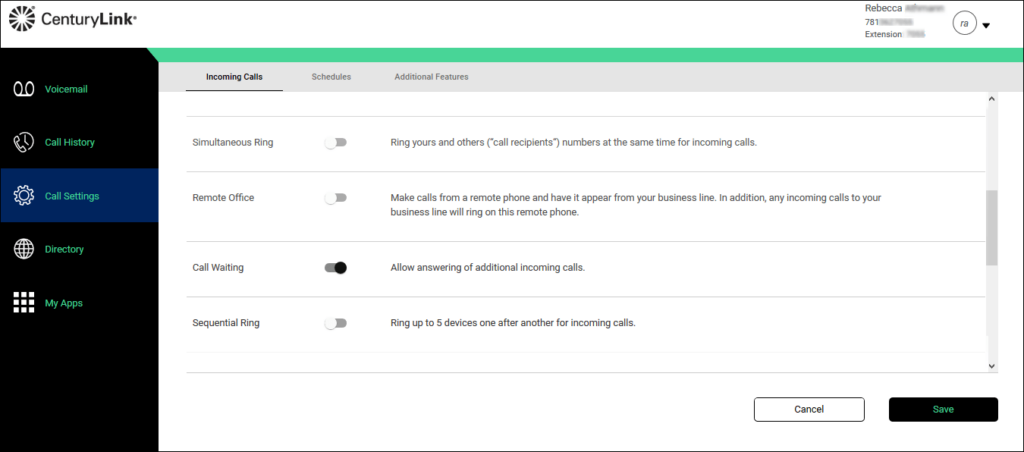Sequential ringing, also known as serial ringing or linear ringing, refers to a call routing feature used in multi-line telephone systems.
It involves ringing a series of phones in a predefined order when an incoming call is received.
The call is routed to the first phone in the sequence and if unanswered, rings subsequent phones one after the other until the call is picked up or times out.
Sequential ringing allows incoming calls to be directed to a group of phones and helps ensure calls are attended to promptly.
It provides flexibility in managing calls and is widely used in office phone systems, call centers, customer support lines, and other multi-extension setups.
Configuring sequential ringing simply involves defining a list of phones in priority order as required by the application.

How it Works?
- A sequence or list of phones is defined in a priority order as required by the application.
- When a call comes in, the system rings the first phone in the sequence first.
- If the call is not answered within a specified time, it proceeds to ring the next phone in the sequence.
- This linear ringing continues down the defined list until a phone is answered or the last phone in the sequence is reached.
Key Benefits
- Ensures calls are attended to promptly.
- Allows calls to be directed sequentially to a group of phones.
- Provides flexibility in managing call routing for optimal customer experience.
- Useful for call centers, offices, support lines, and other multi-extension setups.

Configuring Sequential Ringing
Properly configuring sequential ringing involves defining the right order of phones and setting optimal ring times.
1. Defining Ring Sequence
- Determine the flow of responsibility for answering calls.
- List phones in the order to be run sequentially.
- Place phones requiring the first response at the top.
- Assign priority phones above those with secondary responsibility.
2. Setting Ring Times
- Set ring time at each device based on priority and urgency.
- Use shorter times for higher-priority devices (e.g. 10 seconds).
- Allow longer times for secondary devices (e.g. 20 seconds).
- Set maximum ring sequence time before the call exits the order.
3. Special Options
- Route calls simultaneously to the first set of phones for the quickest response.
- Divert calls to voicemail if unanswered after the full sequence.
- Overflow to a different sequence if the call is high priority.

Implementing Sequential Ringing
Sequential ringing can be implemented in different telephone systems in the following ways:
1. Private Branch Exchanges (PBX)
- Configure sequential ringing for inbound call routes on the PBX.
- Define priority order and ring times for each extension.
- May require creating call groups and call queues.

2. IP Office Platforms
- Utilize ring sequences feature and set priorities.
- Configure time to ring at each step using ring delays.
- Route to voicemail after defined sequence.
3. Cloud-Based Phone Systems
- Create a call flow rule triggering sequential rings.
- Set custom ring times for each step in the call flow.
- Route to alternate numbers or voicemail after sequence.

Use Cases
Sequential ringing provides flexibility in directing incoming calls and is useful in many scenarios:
1. Call Centers
Ring agents in order of seniority or expertise level and Improve customer experience with quicker call routing.
2. Office Phones
Ring department extensions in a set order based on responsibility and Forward unanswered calls to manager phones.

3. Support Lines
Ring level 1, and level 2 support sequentially to reduce wait times and back to voicemail response if unanswered.
4. Remote Teams
Ring employees in different locations sequentially to account for time zone gaps.
5. Sales Teams
Route calls to sales reps by territory, product expertise, or tenure.
Limitations
Some limitations exist in sequential ringing configurations:
- Ring delays can accumulate and lead to longer wait times if sequences are long.
- Important calls may be missed if ring durations are too short.
- Frequent changes in ring order can be hard to configure dynamically.
- Hardware or network faults can break the sequential call routing.
- Not available on some outdated PBX platforms.
- SIP trunking is required for cloud-based sequential ringing.
The Future of Sequential Ringing
Sequential ringing will continue to play an important role in call routing and improve further with these trends:
- Integration with CRM software for dynamic ring orders based on customer data.
- Ability to set sequential ringing using virtual phone numbers.
- Using AI to customize the sequence based on caller ID, time of day, etc.
- Real-time dashboards to monitor sequential ring performance.
- Omnichannel options like adding digital channels into ring sequence.
- Testing capabilities to simulate and optimize sequences.

Frequently Asked Questions (FAQ)
Ques 1. How does sequential ringing differ from simultaneous ringing?
Ans. With simultaneous ringing, all phones ring concurrently. Sequential ringing introduces a defined priority order and time delay between device rings.
Ques 2. Can sequential ringing be used with cell phones?
Ans. Yes, cloud-based phone systems allow including cell phones into sequential ring sequences by using their mobile numbers.
Ques 3. Does sequential ringing require special phone system hardware?
Ans. Some older PBX systems may not support it, but most modern IP and cloud-based platforms include built-in sequential ring capabilities.
Ques 4. Can ring times be customized in a sequential ringing setup?
Ans. Yes, most phone systems that offer sequential ringing allow configuring customizable ring times for each step of the sequence.






